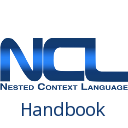Differences
This shows you the differences between two versions of the page.
| — |
edtv-bdtv-profile-introduction [2014/09/16 14:26] (current) |
||
|---|---|---|---|
| Line 1: | Line 1: | ||
| + | ===== EDTV/BDTV Profile Introduction ===== | ||
| + | |||
| + | ==== What is the NCL 3.0 EDTV/BDTV Profile? ==== | ||
| + | |||
| + | EDTV is the acronym for Enhanced Digital TV. | ||
| + | |||
| + | The NCL 3.0 Enhanced DTV (EDTV) profile is the standard declarative language | ||
| + | of the Japanese-Brazilian DTV middleware ISDB-T<sub>B</sub> for fixed and | ||
| + | mobile receivers, and also ITU-T Recommendation for IPTV services. | ||
| + | |||
| + | BDTV is the acronym for Basic Digital TV. | ||
| + | |||
| + | The NCL 3.0 Basic DTV (BDTV) profile is a simplification of the EDTV profile | ||
| + | in which transition effects and metadata functionalities are optional. This | ||
| + | profile is the standard declarative language of the Japanese-Brazilian DTV | ||
| + | middleware ISDB-T<sub>B</sub> for portable receivers. | ||
| + | |||
| + | The following processing instruction must be written in an NCL document in | ||
| + | conformance with these profiles. | ||
| + | |||
| + | <code xml> | ||
| + | <?xml version="1.0"?> | ||
| + | <ncl id="any string" xmlns="http://www.ncl.org.br/NCL3.0/profileName"> | ||
| + | </code> | ||
| + | |||
| + | The //profileName//, in the URI path, identifies the language profile | ||
| + | used to specify the document and must be, in this case, //EDTVProfile// | ||
| + | or //BDTVProfile//, respectively. | ||
| + | |||
| + | Fourteen functionality areas with twenty nine modules are used to define the | ||
| + | Enhanced DTV and the Basic DTV profiles. Attributes and contents (child | ||
| + | elements) of each element of a module may be defined in the module itself or | ||
| + | in the language profile that groups the modules. | ||
| + | |||
| + | In this handbook, each language element is presented in a specific section. | ||
| + | Each of these sections contains a one line element table in which element's | ||
| + | required attributes are underlined. In these tables, the following symbols | ||
| + | are used: (?) optional (zero or one occurrences), (|) or, (*) zero or more | ||
| + | occurrences, (+) one or more occurrences. The value of an attribute may not | ||
| + | contain quotation marks (<nowiki>"</nowiki>). When a value is a string, it must | ||
| + | begin with a letter or an underscore and must contain only letters, digits, | ||
| + | <"."> and "_". | ||
